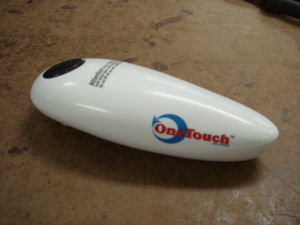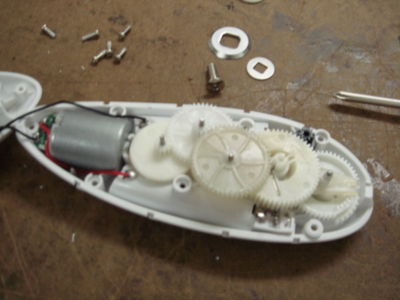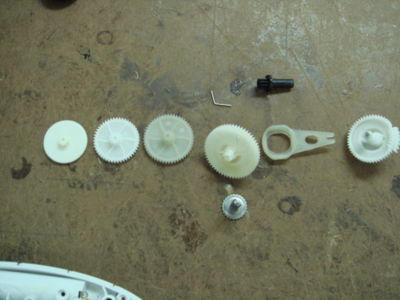Automatic can opener
From DDL Wiki
(→Functional Operation:) |
|||
| Line 378: | Line 378: | ||
|| 36 | || 36 | ||
|- | |- | ||
| + | |||
| + | [[category:design studies]] | ||
Revision as of 01:47, 14 February 2007
The automatic can opener provides an easier way to open cans for all people. The opener takes the work out of turning a knob as well as takes the hassle of fishing out the top from in the can. In general, it is a relatively simple design that doesn't appear to have many easy misuses. The internal funtioning provides a very easy user function process, by automating everything but placing, starting, and removing the opener. It uses its own battery power to move around the can and make the job easier for the user.
Consumer needs for the product are very straight forward. A user is looking for a safe and easy alternative to traditional can openers. The use of the retractable blade is the best feature that the product has to offer for safety. The use of lightweight components also increases usability, allowing for a wider age range of users because ability to lift should not be a problem until the very extremes of young and old. The limited cycle can become tiresome when opening large cans as multiple cycles must be used. The opener can make it around a standard size can for the most part, but once on to larger cans the opener will occasionally leave a small connection of the lid between cut sections.
The opener does not overuse components entirely although some can be removed for a faster assembly time. This may also make dissassembly a little more difficult. Using quick snap connections for the injection molded parts would make assembly considerably easier, although the current molds would have to be altered in order to do so. Failure is still possible with this design as well. One flaw that would be good to fix is a small seal to make the opener water resistant. This would allow for mistakes such as dropping the opener into a sink while it is out of storage. For the most part, the design is very robust and can handle most challenges.
Contents |
Product Analysis
Product Requirements and Consumer Needs:
Product requirements are a direct derivative of consumer needs and as such the two go hand in hand. The One Touch can opener must go above and beyond the capabilities of ordinary can openers. It must completely remove the tops of cans of various sizes and it must do so in a fashion that does not leave serated edges on the lid of the can. Regular can openers cut the top off of a can such a way that it can not be placed atop the can once the contents of the can are done being used. The One Touch can opener must eliminate this problem so that the contents of the can may indeed remain in the can and stay fresh and sealed while still in it. The can opener must also be light and easily maneuverable as there will be a wide age variation in consumers. It needs to run automatically without the user maintaining pressure on the switch, thus the name "One Touch." The One Touch Can Opener must run without electricity and therefore runs on batteries. As all consumers are not savy with electronic or battery operated devices, the can opener must have an easily accessible battery port that is straight forward and simple to place and replace batteries. Finally the can opener must be safe for all operators. It cuts metal so clearly it has a sharp surface which allows it to do so. The blade must be retractable so that it is concealed while the can opener is not in use and therefore the consumer can't mistakenly slice themself on a sharp edge.
Use:
The automatic can opener must first be put into the right position for it to complete its task properly. This correct position is on top of the can. Once it is in the right position the user just has to hold down the button until the opener turns on. Once it is on the user can just sit back and observe. The can opener will eventually make its way all the way around the can, unless the can is larger than standard tin cans. If this is the case, the can opener simply has to be run multiple times until the top is completely cut. Once the can opener has completed its job, the user can simply pick up the can opener. Since there is a magnet on the can opener the lid is attached and can be easily discarded.
Functional Operation:
The actually internal mechanics to how the can opener works is really quite simple. To begin, setting the opener on the top of actually also presses a safety switch. From that point, the main button can be pressed to close a switch that gives power to the motor. Through a geartrain, the speed and torque output of the motor are converted to a reasonable speed with a high enough torque to move the opener around the can while cutting. As the gears move, the cutting wheel is finally exposed from is protective casing and pressed into the can. As this happens a secondary switch is pressed by the top of the cutting wheel shaft. This allows for a timed cycle and for the user to release the button and wait for the opener to finish. Towards the end of the cyycle, the cutting wheel is once again retracted into its casing to dissengage the can. To finish the process the opener can be lifted off and actually lifts the top of the can also using a magnet. There are times when multiple cycles must be used because of can size, but this does not pose much of a problem as it just requires the button to be pressed again.
Components
The can opener has several components and electrical assemblies. It appears that most are purchased from suppliers while casings are injection molded in house. Some components seem like they could be removed to allow for a faster and easier assembly. Also, with a large enough scale of production, it may be beneficial to begin making some of the injection molded gears in house as well. Much more detail as to what individual components are used, what their purpose is, and their likely manufacturing processes.
The geartrain is very compact although it does allow for a large conversion from motor speed to torque allowing for an easily made cut.
DFMA Analysis
Design for Manufacturing:
- The upper and lower casing are both made in house by using the method of injection molding.
- Most of the other parts like the screws, pressure switch and the motor are bought by suppliers, so it won’t be hard to buy.
- The Gear components in the gear train in this product should be currently bought from other suppliers as well and could be made in house using the process of injection mold plastics, so it shouldn't be hard to produce.
- Movement wheel and the washers are both stamped
- The Cap screw and the magnet are both produced by cast
- Overall, the whole manufacturing process is very cost effective and most of them are produced by molding and stamping.
Design for Assembly:
- The casings are securely attached by screws. It is very easy, simple and straight forward.
- The internal wiring has obvious tracks to help guide wires so it will be aligned.
- The Circuit board and the capacitors are soldered in so it will be secured and hard to disassembly.
- Gear Trains and the movement gear are all secured by shafts
- The Bent Pin is used to attach the movement gear to the movement wheel
Design for Disassembly:
- Easy dissemble for most parts as most of them are attached by shafts and screws
- The more difficult areas would be the motor itself and the circuit board (soldered in)
Design for Environment
- This product of the automatic can opener is can definitely be more environmentally friendly by using better materials of components (gears).
- Use better manufacturing processes and better handling of the waste of harmful materials.
- The design itself can be more optimal, so it wouldn’t require more than required of these harmful materials.
Opportunities for Improvement
- Many parts like the gears that was ordered from suppliers could be made in house, even though that would mean a larger cost at the beginning, but it will be well worth it in the long run.
- Currently we are using a set of many gears to generate the torque and the ideal speed for the product, but there by calculating the gearing ratio and the torque needed we could find a more optimal solution to the amount of gears we use.
- The motor offers speed but not much torque itself, which is one of the reasons why we require many gears in the gear train, we can definitely improve in that aspect.
- There are way too many screws attaching the lower case and upper case, many could be eliminated if the the design of the casing changes.
- The switches, the reset button is exposed to the air, if by accident that the can opener is submersed in water, it could affect its functionality. Therefore making these areas waterproof and seal off any open exposed areas would be ideal.
- Use better components that would lead to more environmentally friendly process.
Failure Modes and Effective Analysis
| Part Number | Part Name | Failure Mode | Effects of Failure | S | Causes of Failure | O | Design Controls | D | RPN |
|---|---|---|---|---|---|---|---|---|---|
| 001 | Screws(large) | * A screw that is detached from the casings | That would lead the casings to fall apart and not attached | 2 | Due to rotting or overstress | 2 | Manual | 2 | 36 |
| 002 | Pressure switch | * It cannot not detect whether the battery case or the opener is in place | That would be dangerous and one of the safety features will be lost | 4 | Overuse and the connection between those components are loose due to deformation | 4 | Manual | 2 | 14 |
| 003 | Movement Wheel | * Cannot provide the necessary pressure to the cutting wheel to pierce can | That would make the automatic can unworkable | 2 | That may due to overuse and deformation if the opener was hit or environmental influences | 2 | Material | 3 | 4 |
| 004 | Cap Screw | * Cannot attach the cutting wheel to gearing | That would lead make the cutting wheel not work as the gears would not be able to provide the torque required | 2 | Due to rotting or overstress | 2 | Manual | 2 | 36 |
| 005 | Cutting Wheel | * Cannot cut through can to remove lid | That would make the whole can opener lose its function | 4 | Due to overuse, material corrosion | 3 | Material and Manual evaluation | 2 | 12 |
| 006 | Magnet | * Cannot keep the top off from submersing into the can when it is cut off | That would lead the can top to fall into the can | 1 | Losing its polarity due to environment | 7 | Manual evaluation | 6 | 11 |
| 007 | Reverse Switch | * It does not reverses the direction of the motor | That would lead the cutting procedure to fail | 2 | Error from the circuit board | 2 | Manual calculation and evaluation | 3 | 6 |
| 008 | Manual Pinion | * It does not allows manual rotation of the gear system | Lost the manual dimension control | 2 | Overuse and led to a lack of sensitivity | 6 | Manual calculation and evaulation | 7 | 10 |
| 009 | Positive Terminal and Negative Terminal | * No power is transmitted | The automatic opener will not have any power | 2 | The connection might be off due to deformation | 3 | Manual evaluation | 4 | 15 |
| 010 | Main button | * No power is transmitted | The automatic opener will not start | 2 | The connection might be off due to deformation | 3 | Manual evaluation | 4 | 15 |
| 011 | Internal Switch | * No circuit so there will be no power | The circuit will not be complete | 8 | The connection might be off due to deformation | 4 | Manual evaluation | 5 | 17 |
| 012 | Motor | * Cannot drives geartrain, movement wheel, and cutting wheel | The motor is the element to provide speed and connection to the gears | 4 | Overuse, overheat | 2 | Material, Manual evaluation | 6 | 12 |
| 013 | Ratio Gears | * Unable to gear down motor output | The whole can will be inoperative | 2 | Overuse, deformation | 3 | Material, Manual evaluation | 4 | 24 |
| 014 | Shafts | * Unable to sustain the gear train to usable speed and torque | The whole can will be inoperative | 6 | Overuse, deformation | 3 | Material, Manual evaluation | 7 | 36 |










